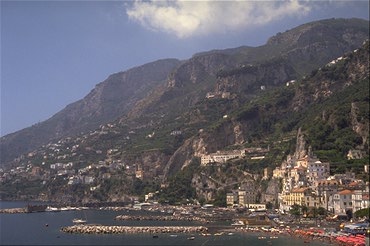|
Amalfi place of everlasting spring In this heavenly nook, history and legend are woven together to create an inseparable whole. According to the tradition, Hercules loved a nymph called Amalfi. She died and Hercules buried her in the most beautiful place of the world. To immortalize her, he gave the place her name, Amalfi. Amalfi was the oldest maritime republic in Italy and was powerful and prospered because of its role in Mediterranean trade during the tenth and eleventh centuries. The merchants of Amalfi traded spices, scents, silk and precious carpets. The 116 oar galleys built in Amalfi were the largest in the Mediterranean. In the tenth century Amalfi coined the golden and silver Tarě, that were used in the Greek Empire and beyond. The wealth of Amalfi was so great that gold, silver and everykind of fabric were abundant and it was visited by Arabians, Sicilians, Africans and Indians. The great bronze doors of Amalfi cathedral, which were made in Constantinople in 1066 by a copper artist, Simeon of Syria, were a gift from the son of Constantino di Pantaleone di Mauro. The doors are divided into twenty four panels with four pictures: Christ, the Madonna, Saint Andrew and Saint Peter. About 533 Amalfi was under the rule of the Byzantine Empire. It was a diocese and the bishop provided for the defence of the town. Some landowners deprived the bishop of his political power. In 836 Sicardo, duke of Benevento, raided Amalfi, deporting the inhabitants to Salerno. In 839, Sicardo was killed, the Amalfitans rose and maintained their autonomy until the end of the eleventh century. Amalfi became Republic in 850. Very often Amalfi united itself with Saracens and Ludovico II against Byzantine attempts to restore the sovereignty of the Eastern Empire. The alliance with the Saracens was unstable, in 915, after a very cruel battle, the Saracens were defeated. For all the tenth century and the beginning of the eleventh century, the Amalfitans prospered and were independent. The famous " Tabula Amalphitana " was the most accredited code of all the sailor nations of that time. It controlled the relations between ship's master and sailor, between sailors and traders. Legend gives to Amalfi the credit to have perfected the compass for the navigation. In 1039 Guaimario V, prince of Salerno, took possession of Amalfi's dukedom, with the dominion of Salerno on Amalfi. Pressed by Salerno, the amalfitans governed by Sergio IV, asked Roberto il Guiscardo, in 1073, to help them. Salerno capitulated but amalfitans were conquered by Normans. After thedeath of the Norman king in 1085, Amalfi tried to be free of Norman power. In 1135 Amalfi suffered an horrible sack by Pisani, traitors, called for helping against Normans. It's from now that begins Amalfi's decay. In 1343 a terrible sea-quake, described by Petrarca, hit the coast, the most part of the town was destroyed ( probabily with it also the Ducal Palace, mentioned in a document as Palatium Amalphitanum ), the fortifications were submerged, the shipyards, nautical equipements. Five years later, the famous plague of 1348, described by Boccaccio, completed the destruction among people. Amalfi and all coast's towns, that were beautiful places, populated and fortificated, rich of beautiful places, decorated by frescoes, marbles, columns, fountains, became modest towns, without richness, coming back to the traditional economy: fishing, local handicrafts, agriculture. Only at the end of nineteenth century, tourism gave to Amalfi a very big increase, that now is the economic epicentre of all the coast that from Amalfi takes its name. |
> Amalfi > St John > Pilgrims > chivalry > St John |
